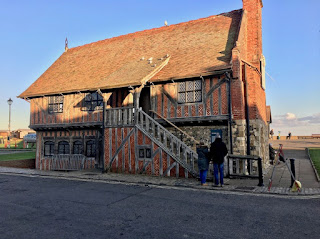Being moved in Aldeburgh
The couple of times I have been in Aldeburgh, I’ve wished the sun was on this side of the Moot Hall, better to show off the beautiful timberwork of the staircase – and I’ve resolved to return another time, earlier in the day, when this west-facing wall would be in better light. The next time was to have been November 2020, but Covid put paid to that. So when I look back at my Aldeburgh photographs, they have a special poignancy and bring with them thoughts of ‘maybe later this year…maybe next’.
The Moot Hall has other resonances for me. First, built in c. 1520 and altered in 1654, it’s a glowing example of Tudor and Stuart timber-framing, stonework and brickwork. There was a restoration in the 1850s, when a lot of the brick nogging* was replaced (the lower floor nogging and the gable end are mostly Victorian, the upper floor 17th century). The external staircase was restored in the 19th century too – but very much as it would have been. It’s not hard to imagine the people of Tudor or Stuart times holding their market downstairs and having town meetings in the upper room. Back then it would also have been even more of a local landmark than it is now, a village hub right on the beach, as close to the sea as the lives of nearly every Aldeburgh citizen would have been.
The Moot Hall is also one of the settings of Benjamin Britten’s opera Peter Grimes, the work that marked his comeback to Britain after a spell in the USA – and which changed the direction, decisively and beneficially, of English opera. The opera’s Prologue is set in the Moot Hall and the work’s plot and music are soaked with the sea – the fate of Peter Grimes and his doomed apprentices is bound up in the sea, and Britten’s music resonates with it, evoking storms and calms alike.† The composer himself, an Aldeburgh resident for much of his life, must have seen the sea most days, looked at it, listened to it, swam in it – and it shows in his music.
A building like this must have many meanings for those who look at it. I’ve simply described what it means – personally, architecturally, musically – to me. They’re the reasons, if you like, why it moves me. Ian Nairn, one of England’s greatest writers about buildings and places, said that in writing his book about London he wanted simply to record, ‘what has moved me, from Uxbridge to Dagenham’.§ That’s one of my aims, when I write this blog, though one can only dream of matching Nairn’s aim with his insight.
- - - - -
* Nogging is the architectural term for brickwork that is used to fill the spaces between the wooden posts and beams of a timber frame. The bricks are sometimes laid in an ornamental pattern, as they are here.
† One way to appreciate this sea-music, especially if you don’t like opera, is to listen to the four orchestral Sea Interludes (‘Dawn’, ‘Sunday Morning’, ‘Moonlight’, and ‘Storm’) that are played during the opera and can be performed separately from it. There are performances on YouTube, including this one.
§ One of my blog posts on Nairn is here.




1 comment:
Phillip I don't know this as fact but the Moothall may have been further from the sea when it was built given the steady loss of land along this coast over the centuries. C.f. Dunwich nearby. CHJ
Post a Comment